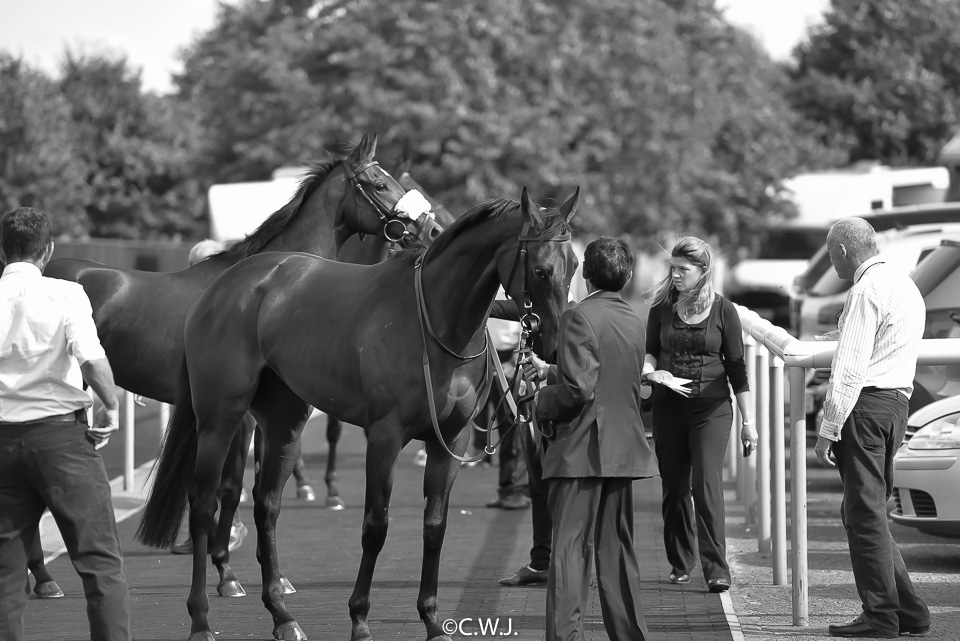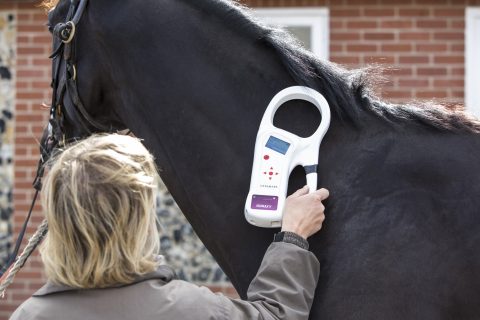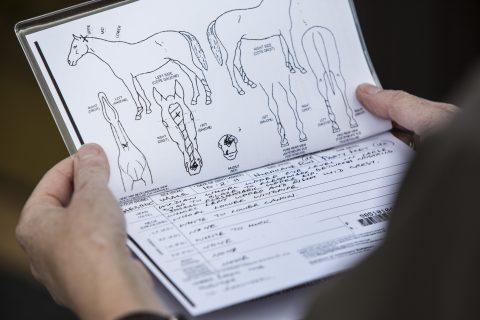The Western Meeting: An EWIO’s view of the Ayr Gold Cup Festival

BHA Equine Welfare and Integrity Officer Cal Pannone blogs about the responsibilities of the BHA in protecting horses’ welfare and integrity at a busy race meeting.
The Ayr Gold Cup meeting is one of the highlights of the Scottish calendar, and with large fields entered for each of the three days, it’s a busy one for the team of Equine Welfare & Integrity Officers (EWIO’s) on duty.
 Our role is to provide the regulatory and welfare function of the British Horseracing Authority (BHA) within the stable yard, and to secure samples for testing as part of the BHA anti-doping policy. At most meetings we work in teams of three officers, working a shift which starts four hours before the first race, and continues until all horses are out for the last, the final horse leaves the sample unit and the samples are secured and locked away.
Our role is to provide the regulatory and welfare function of the British Horseracing Authority (BHA) within the stable yard, and to secure samples for testing as part of the BHA anti-doping policy. At most meetings we work in teams of three officers, working a shift which starts four hours before the first race, and continues until all horses are out for the last, the final horse leaves the sample unit and the samples are secured and locked away.
The Ayr meeting is big, so our team expands to cover the extended duties. It’s a great chance to catch up with colleagues we haven’t seen for a while, and whilst the hours are long we work closely together to share tasks and cover duties in the most efficient way possible.
Work starts before the meeting does, as the longest travelling horses start to arrive from lunchtime the day before. The stable manager allocates boxes, but only staff with properly accredited passes can access the yard once the EWIOs are on duty. The first EWIO on the ground keeps an eye on the condition of the horses arriving, making visual checks of shoeing (all flat turf horses must be shod all round unless they possess previously agreed dispensation) and signs of ringworm, and checking that staff know not to bring in any prohibited substances to the yard. Horses may only consume their normal feed and water on a raceday, although permission for glycerine pre-race and electrolytes post-race may be granted.
By 6.30pm the EWIOs on night duty arrive. At large meetings running over several days our team preserves the integrity of the yard for the entire period, with team members working a 12 hour shift to make sure that late arrivals are allocated suitable boxes, and that no one has access to the stable yard without the relevant pass. They also check regularly that the horses are all settled, keeping an ear out for any signs of colic or restlessness whilst trying not to disturb those horses who are fast asleep!
By 6.30am the first two EWIOs from the day shift are in and working flat out, signing in the stable staff coming in for morning feed, and making sure that they all have an easily identifiable wristband. A third EWIO shows up at 6.45 to open up the top gate and allow horses onto the track for a stretch of the legs or a pick of grass.
Soon the remaining four EWIOs arrive, enabling the early crew to grab some breakfast before starting to scan all the horses who are running today. Every horse has its microchip checked to ensure there are no cases of mistaken identity, and the data on each horse is linked to its box number, so that should anything untoward occur we have a record of where each horse was stabled, enabling us to search the box and also check the relevant CCTV camera if necessary.
On top of that there’s a substantial passport list to get through; first time racers have a thorough examination to check that their markings and whorls are correctly marked on the passport, and older horses checked to ensure they are still the same colour as they were first identified (changes happen more often than you think!) still colts, or have been gelded as appropriate. The vaccination dates are also checked, ensuring that every horse is fully inoculated against equine influenza, making an outbreak in racing much less of a threat.
By now the BHA Veterinary Officer has arrived, and is busy stamping up the passports and responding to any concerns or questions from the EWIO team. Horses can be required to trot up to check for soundness.
The EWIOs also staff the stable gate, scanning horses arriving just for the day, chasing up missing passports and ensuring we see everyone’s stable pass. Before we know it there’s an hour until the first race, so one of the team attends the Stewards briefing with the VO, and the EWIOs on sampling duty leave to set up their sample kits in the unit at the top of the yard.
 During the afternoon the emphasis shifts to the top yard gate, adjacent to the parade ring. It’s a hive of activity here, with trainers coming in to saddle up, and often asking if they can bring in owners to see their horses too. Owners can be signed in at the discretion of the EWIO team, and if we are sure of their identity, so one of the team is kept busy checking out requests for access whilst another two keep an eye on the horses and staff coming in and out of the yard. Once racing starts the team are busy passing on messages to the farrier or the team of racecourse vets who may need to dress any small cuts or other injuries, organise scopes for horses who have run under par, or replace slipped shoes.
During the afternoon the emphasis shifts to the top yard gate, adjacent to the parade ring. It’s a hive of activity here, with trainers coming in to saddle up, and often asking if they can bring in owners to see their horses too. Owners can be signed in at the discretion of the EWIO team, and if we are sure of their identity, so one of the team is kept busy checking out requests for access whilst another two keep an eye on the horses and staff coming in and out of the yard. Once racing starts the team are busy passing on messages to the farrier or the team of racecourse vets who may need to dress any small cuts or other injuries, organise scopes for horses who have run under par, or replace slipped shoes.
Meanwhile after each race the stewards select horses for sampling, and they are brought to the unit. We double check their identity with the microchip scanner, record their pulse and respiration rates, and send them off for a wash down and walk around, monitored by staff from the racecourse. After each horse has settled as much as it is going to, they are brought into one of the sample unit boxes and let down, to allow the EWIO to collect a sample of urine. If the horse is obliging then the sample is packed up, witnessed by the stable lad or lass, and the horse allowed to leave. If the horse cannot produce a sample in the time available then the VO will collect blood. It’s a matter of personal pride to most EWIOs that they can settle most horses and collect a urine sample.
And as this is only the first of several days of racing, the team in the bottom yard office now start to get busy again as runners for the next two days start to arrive. After many hours on a wagon the staff are keen to put their horses away, but with only 170 boxes available, and 130 runners in for today’s meeting there can be a slight delay, especially when large contingents turn up all at once, requiring ten or twelve consecutive boxes. The stable manager is flat out organising his team of muckers out, and the EWIOs do their best to help make the process go as smoothly as possible.
By day three of the meeting the stable yard is still running like clockwork. A couple of requests for a vet keep the bottom yard office ticking over, whilst the crowds around the pre-parade ring keep the top gate EWIOs on their toes. By the time the Ayr Gold Cup is over the two team members with the furthest to go (this year our furthest traveller had a nine hour journey home) head for the hills, leaving those more local to the course to stay until the very end. A quick check around once they’re all out for the last, and then it’s time to say our goodbyes, collect up the paperwork and go home, hoping to miss the worst of the traffic. Last to leave are the EWIOs in the sample unit, packing up their samples and securing them ready for collection in the morning. By now the yard has magically emptied, with only a few horses remaining overnight, and peace is restored.
Until next time.
Top image copyright: C.W.J.
